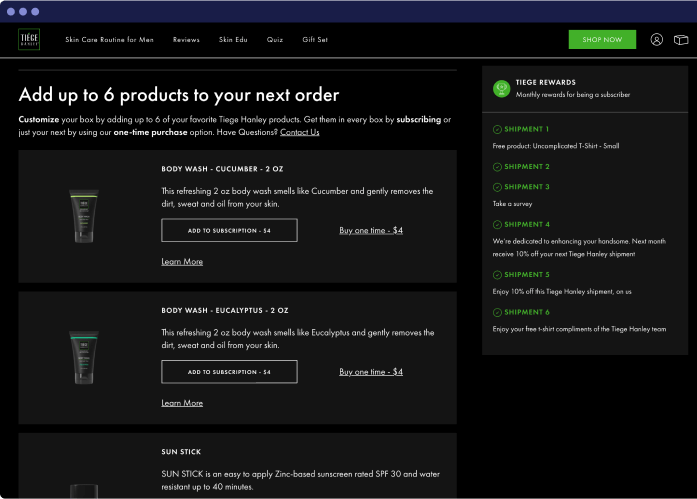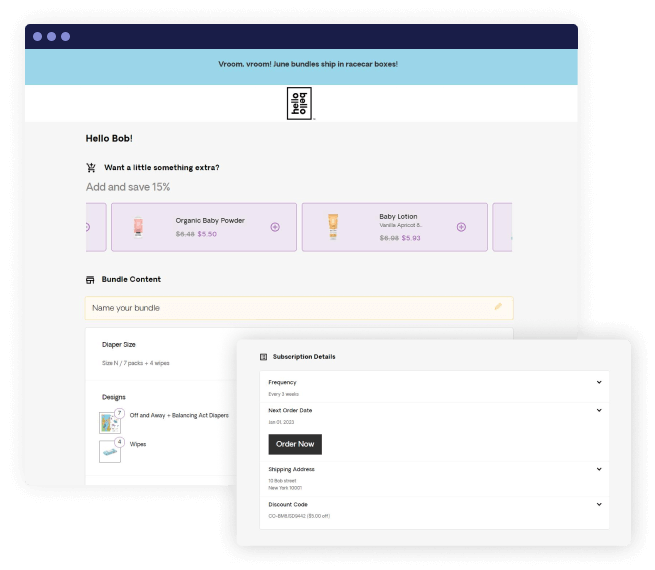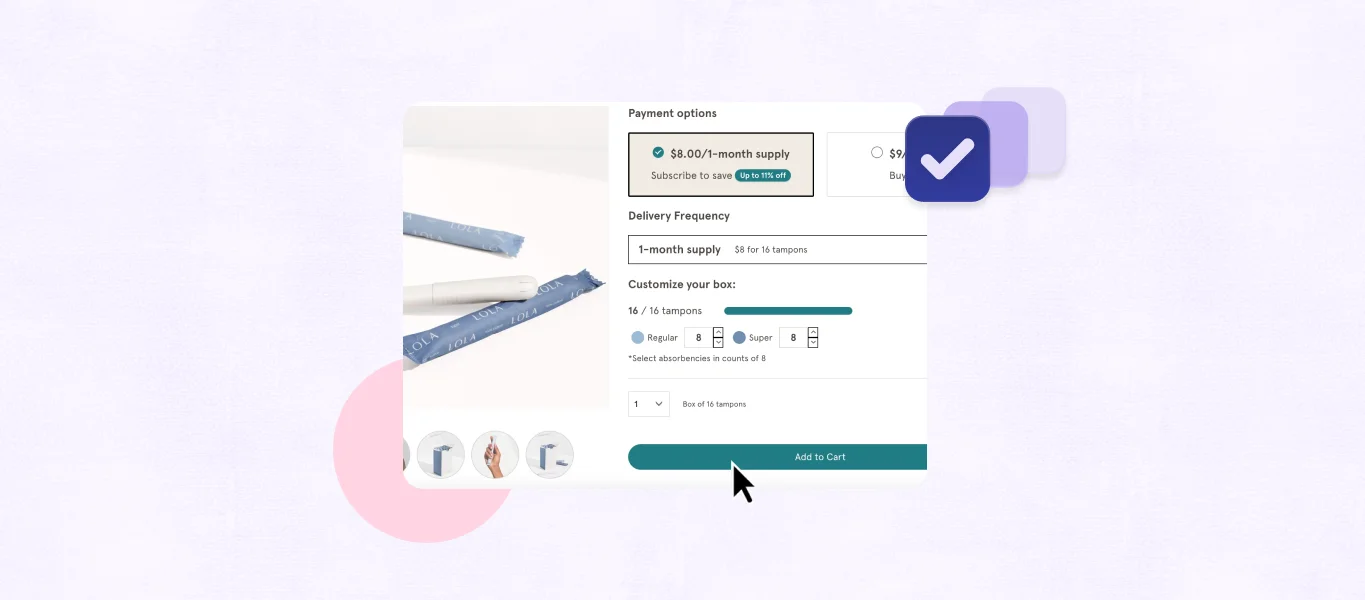In its best form, cross-selling isn’t purely transactional. Sure, your brand is marketing complementary items or services to your existing customers. And of course, cross-selling is a powerful strategy for increasing revenue, average order value, and lifetime value—particularly for subscription businesses.
But when cross-selling efforts are made effectively, your customers receive even more value. They get product recommendations perfectly customized to their unique desires and needs. That saves them the time they would have otherwise spent searching for those products and helps them find better product matches. What’s more, it instills trust in your brand, builds loyalty, increases engagement and customer satisfaction, boosts customer retention, and keeps your customers with your business longer.
In other words, cross-selling has the power to transform your brand presence from that of a salesperson to a trusted friend. That’s relational commerce at its finest—and it helps you form meaningful customer relationships that stand the test of time.
What is cross-selling?
Hazy on the specifics of cross-selling? Let’s back up a minute.
Cross-selling is a sales tactic that involves showing customers related products or services to their original purchase. For subscription ecommerce businesses, this can mean recommending a one-time purchase or an additional, related subscription.
A classic example of a cross-sell is a movie theater asking if you want to add on a drink with your popcorn. Another example: When choosing their recipes for the upcoming week, a meal kit subscriber might see that they can add on a one-time purchase of a snack or dessert to their order for an additional charge.

Cross-selling is often discussed in tandem with upselling, a related strategy that shares many of the same goals: increasing average order value, lifetime value, and customer satisfaction. However, while cross-selling focuses on adding on products and/or services to a customer’s existing order, upsells attempt to convince a customer to upgrade their original order to a more expensive version with a higher perceived value.
In this post, we’ll focus specifically on cross-selling strategies that top brands use to nurture relationships with their customers and boost revenue. To read more on upsell and cross-sell strategies from our agency partners, check out our Powerful & Profitable Series: Cross-Selling and Upselling playbook.
Effective cross-selling strategies
Now that we’ve gone over the basics, let’s dive into some of the key strategies your brand can use to effectively cross-sell products, drive sales, delight customers, and increase revenue.
Personalization is everything
The key to any effective cross-selling strategy is personalization. Why? Well, of course, this increases the likelihood that your customers will purchase a complementary service or product. But on a deeper level, a customized approach makes the customer feel understood. It shows that you realize their unique needs and challenges and want to help address them, further strengthening that customer relationship.
“Personalized recommendations are key. You wouldn’t want to recommend meat products to a customer that’s subscribed to your vegan box, would you? To return to our relationship metaphor, in this way cross-sells and upsells can function as love notes: I know you, I’m thinking of you, and I want you to have all the things. They keep customers engaged with your brand, making them less likely to want to quit you.”
Z, Founder at Tako Agency
To do this effectively, it’s crucial to get to know your customers, studying their past purchases, product ratings, and feedback, and pain points. From there, you can tailor your recommendations to make that customer experience even more seamless. Subscription businesses have a unique advantage here due to the recurring nature of their products, which allow them to get to know their customers over a longer period of time.
Segment your existing customer base
Why is segmentation in cross-selling important? Within your larger customer base, there are a variety of types of customers who each interact differently with your products and services. By segmenting those customers into different cohorts, you can tailor your approach to each rather than employing a one-size-fits-all approach to cross-selling.
Again, it all ties back to personalization. By tailoring your suggestions, you cut through the noise for your customers, providing them with the additional products and services they need.
“The trick here is to establish the rules and hierarchy for your products and reveal upsell or cross-sell options to the RIGHT customers based on what they have in their cart, or their order history.”
Tate Lucas, CEO at DotDash.io
Analyze your customer journey
In any relationship, timing is everything—and customer relationships are no different. When given at the wrong time, recommendations for complementary products can flop.
To prevent this, map out your customer journey and identify the unique needs of each stage. Are your customers repeatedly visiting certain product detail pages on your site after their first few purchases? This might be a great opportunity to use email marketing to cross-sell that product type to those customers.
Consider a “frequently bought together” section
When thinking about cross-selling, for many people, Amazon’s “frequently bought together” section on its product detail pages comes to mind. This type of site feature can include product bundles of multiple products, as well as options for purchases of single items, and uses past purchase history and behavioral data to automate product recommendations.
A “frequently bought together,” “frequently purchased together,” or “other products you may like section” can be a highly effective strategy for increasing AOV for your business. However, you’ll want to be sure there’s still a level of personalization to your suggestions here based on customer behavior to avoid offering the same cross-sell opportunities to all your customers.
Offer discounts for add-on purchases
“Consider offering discounts for add-on products …. Don’t be afraid to offer a lower-priced subscription product—you can always leverage add-ons as a way to increase the AOV.”
Thomas McCutcheon, Founder & CEO at Scoutside
Cross-selling is all about increasing value for your customers, which in turn increases the value for your sales team. One tried-and-true way to do this is to create a financial incentive for your users by offering a discount for your add-on purchases. This can encourage your subscribers to try items from different product categories, and can also be a great way for your brand to test the viability of new products while increasing your AOV.
You can also create order thresholds where your customers receive a discount off their order or free shipping once they meet a certain purchase minimum. This, too, can encourage your customers to take advantage of cross-sells and go beyond ordering the same product with each delivery.

Make it seamless
Making your user experience seamless is important for the success of every part of your business, and cross-selling is no exception. When the purchasing process for add-on products or services is intuitive and accessible, your customers are more likely to make additional purchases to their subscriptions.
For cross-selling, your customer portal is a particularly important area to focus on, as are your product detail pages. Utilize one-click technology when possible, display your add-on offerings and any discounts clearly and prominently, and make navigation of these pages as frictionless as possible.
Additionally, you’ll want to focus on your omnichannel experience. Make sure that it’s easy for your customers to take advantage of cross-sells whether they’re on a computer, mobile device, or even accessing your site through a social media ad, and ensure your page loading speeds don’t interrupt the browsing experience.
In conclusion, cross-selling opportunities can create long-term value for both your customers and your brand…
…that is, when they’re done with care, purpose, and personalization. Tailor your recommendations to the specific needs and desires of your customers, and back those suggestions up with thoughtful data and feedback. In doing so, you can not only increase your AOV and revenue, but build a foundation for trusting and lasting customer relationships.



